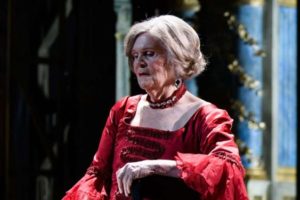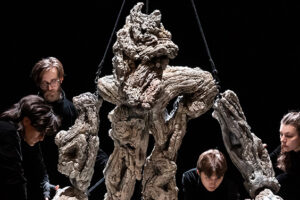

“Operatic” generally refers to sung drama, but there is another meaning of that term: grandiose, outsize, hysterical. The Cinderella now on display by Company XIV (does the numeral refer to King Louis?) at the tiny Minetta Lane Theatre in Greenwich Village is outsize, grandiose, hysterical, somewhat musical and rather rude, fiercely entertaining in a soft-core way.
Somewhere down a dark alley off the Boulevard Foucault, where sequined jockstraps and pasties are de rigueur—leather straps and commodious wigs for more formal moments—and high-heeled court shoes, to be sure—at the Folies Bergères on the Place Burlesque, you will discover this retelling of Perreault’s 1697 fairy tale. Charles (as we called him back in the lycée) would be nonplussed by the Company XIV version, but then he never really got over the mis-translation of “squirrel fur slippers” into glass 300 years ago.
And then there was Rossini (bracelets) and Prokofiev (oranges) and Rodgers & Hammerstein (television) and Sondheim, not to mention the vehicles of Betty Boop and Anjelica Huston. What new wrinkle can they find in that old shoe?
Perhaps “come-fuck-me” pump, open-toed and strappy.
Austin McCormick, who directed choreographed Cavalli’s kinky Elagabalo for Gotham Chamber Opera of sainted memory, has produced a Cinderella that reminded me of “Broadway Bares” in its enthusiasm. The frank display of slim, fit bodies of many genders, doing dance steps and athletic routines to lip sync or in their very own voices, the inappropriate touching of bodies, their own or anyone else’s, the sly obscenities hither and thither, where you least expect them unless you’re always expecting them—XIV is always frankly everything.

Is there any dramatization of this story, by the way, where Cinderella’s stepfamily are not most of the fun? At the Minetta Lane, Davon Rainey plays Mom, apparently channeling Josephine Baker (especially when he dons a yellow wig). Rainey is tall and slim and black and sings fluent mime. He can alter a character or the object of his satire with a whisk of malicious dimple or, with a single thunderous stamp on the ground, create a new rhythm for the dance. He owns the stage whenever he’s on it.
The stepsisters are actual opera singers, Brett Umlauf, who belts one hell of a “Jealousy” and wears a full-rigged ship in her coiffure, and Marcy Richardson, whom I last heard in Handel’s Agrippina. Just when you think the show thus far can’t be topped, Richardson performs Gounod’s Jewel Song (with a trill and without a mic!) while doing an aerial pole routine, 180-degree splits and pinwheels that, one would have thought, made use of the very abdominals that support her admirable soprano. Evidently she keeps two sets of abs in that taut, tiny body. Eat your heart out, Jeanette MacDonald.
The Prince is ginger-haired Steven Trumon Gray, languid and effete in his bathtub warbling “None But the Lonely Heart” (in Russki!) wearing red-stained high heels and little else (red heels were a fashion statement at Versailles). He uses his muscles superbly later in the evening, when he spins around on a hoop, hoisting and tossing his frail (but not that frail!) Cinderella, ably and submissively danced and trundled about by Allison Ulrich. The Fairy (godmother my aunt fanny—but fairy I’ll grant you) is sluttishly vamped by Katrina Cunningham.

Designer Zane Pihlstrom has mastered the stylish use of acres of twinkly and tawdry fabric to conceal almost nothing. I loved the mustache on a stepsister; Sarah Cimino did the makeup. The lighting is by Jeanette Yew and Devin Cameron—when a spotlight falls on Mama, she lets out a yell of anguish—but then Cinderella finds her her shades.
As for Mr. McCormick, to whom conception, choreography and direction are credited, I’d love to turn him loose on Robert le Diable or Alcina or Die Gezeichneten. This show, though, runs through November 15, then will be replaced by a holiday program, Nutcracker Rouge. Oh my!
Photos, to bottom, by Nir Arieli, Mark Shelby Perry and Phillip Van Nostrand.
























Comments